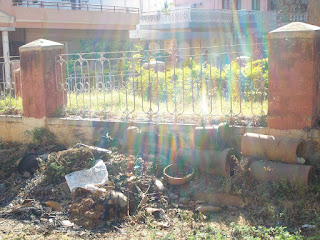Thursday, 31 July 2008
Myth about Water Purifiers Exploded
Wednesday, 16 July 2008
MCC should clear footpath encroachments in the suburbs also
The footpath clearance drive launched by MCC on Ashoka Road (fish vendors) and Devaraj Urs Road (shopkeepers) is commendable. But the last few footpath clearance drives of MCC seem limited to the central parts of the city. It is desirable that the clearance drives are extended to various extensions of the city as well. The attached photographs show some glaring footpath encroachments in Jayalakshmipuram, V.V. Mohalla and Yadavagiri.
1.The footpath next to HSBC Bank (near Panchavati), Kalidasa Road, V.V. Mohalla.

2.The footpath next to MORE (near Chandrakala Hospital) on Kalidasa Road, Jayalakshmipuram.
3.The footpath next to Vikram Hospital, Vivekananda Road, Yadavagiri.
Friday, 11 July 2008
INDIA'S MINERAL POLICY - SOME ISSUES
3. The leasing process should be streamlined to minimize delays.
Thursday, 3 July 2008
NIRMALA NAGARA Programme: Is It Working?
D.V. Dayanad Sagar, member, Mysore Grahakara Parishat writes
Nirmala Nagara programme was launched with great fanfare last year. Its avowed purpose was to clean up Mysore and make it attractive. Has it made a difference? We offer some photographic evidence.
1. Burning Garbage next to park in Gokulam 3rd Stage (Municipal workers are still burning garbage even though burning garbage is illegal and punishable.)
2. Garbage at Gokulam 3rd Stage 4th Main, 11th Cross (Persons collecting garbage door-to-door are supposed to transport it to the landfill outside the city. Instead, they are dumping it in the neighbourhood itself. They demand that garbage be segregated before collecting it. If all the garbage is dumped together, what is the point is segregating it in the first place?)
3. Garbage at Hebbal Tank (Despite repeated reminders, authorities are not taking any action against people polluting the lakes of the city by dumping garbage and building debris.)
4. Garbage behind K.R. Hospital bus stop (This has become not only a garbage dump, but also a public urinal, thus offending both eyes and nose. How can this be allowed in the heart of the city?)
5. Garbage burning in front of K.R. Hospital (Using the premises of the largest hospital in Southern Karnataka to dump mounds of garbage is inexcusable, but burning it and forcing patients to breathe the poisonous fumes is outright criminal.)
6. Garbage in front of Cheluvamba Hospital (Not to be outdone by K.R. Hospital, there is a huge pile of garbage in front of the neighbouring Cheluvamba Hospital as well!)
7. Garbage next to palace at the end of KSRTC bus stand (Lakhs of tourists who visit the Mysore palace have to carry back memories such as this!)
8. Garbage on Chamundi Hills (Chamundi Hills, which is not just a major tourist attraction, but also a major pilgrimage centre, has probably never been cleaned since the beginning of history. The garbage is just thrown down.)



